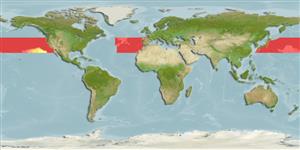>
Argentiniformes (Marine smelts) >
Opisthoproctidae (Barreleyes or spookfishes)
Etymology: Dolichopteryx: Greek, dolichos = long + Greek, pteryx, = wing, fin (Ref. 45335); longipes: longipes refers to the long pelvics (Ref. 4525).
More on author: Vaillant.
Environment: milieu / climate zone / depth range / distribution range
Écologie
marin bathypélagique; océanodrome (Ref. 51243); profondeur 500 - 2400 m (Ref. 74511). Deep-water; 45°N - 27°N, 180°W - 180°E
Probably worldwide in temperate and tropical waters. Eastern Pacific: California Current region (Ref. 35626). South China Sea (Ref.74511).
Taille / Poids / Âge
Maturity: Lm ? range ? - ? cm
Max length : 18.0 cm SL mâle / non sexé; (Ref. 6542)
Description synthétique
Clés d'identification | Morphologie | Morphométrie
Rayons mous dorsaux (Total) : 10 - 11; Rayons mous anaux: 8 - 9; Vertèbres: 46 - 47. Body deep. Short pectoral fins, long ventral fins. Relatively large head and absence of ventral light organs. Line of dark chromatophores along the body below lateral line (Ref. 37473).
Oceanic and mesopelagic species (Ref. 6686). Taken regularly at depths shallower than 458 m, with scientific deep-sea fishing gear. Feed mainly on small crustaceans, particularly copepods (Ref. 4525). Oviparous, with planktonic larvae (Ref. 35626) and eggs (Ref. 6686). Paedomorphic (Ref. 35626).
Life cycle and mating behavior
Maturité | Reproduction | Frai | Œufs | Fécondité | Larves
Quéro, J.-C., 1990. Opisthroproctidae. p. 241-243. In J.C. Quero, J.C. Hureau, C. Karrer, A. Post and L. Saldanha (eds.) Check-list of the fishes of the eastern tropical Atlantic (CLOFETA). JNICT, Lisbon; SEI, Paris; and UNESCO, Paris. Vol. 1. (Ref. 6542)
Statut dans la liste rouge de l'IUCN (Ref. 130435: Version 2024-2)
Menace pour l'homme
Harmless
Utilisations par l'homme
Pêcheries: sans intérêt
Outils
Articles particuliers
Télécharger en XML
Sources Internet
Estimates based on models
Preferred temperature (Ref.
123201): 3 - 5, mean 4.1 °C (based on 66 cells).
Phylogenetic diversity index (Ref.
82804): PD
50 = 0.5020 [Uniqueness, from 0.5 = low to 2.0 = high].
Bayesian length-weight: a=0.00427 (0.00162 - 0.01126), b=3.10 (2.88 - 3.32), in cm total length, based on LWR estimates for this (Sub)family-body shape (Ref.
93245).
Niveau trophique (Ref.
69278): 3.0 ±0.00 se; based on food items.
Generation time: 2.2 ( na - na) years. Estimated as median ln(3)/K based on 1
growth studies.
Résilience (Ref.
120179): Milieu, temps minimum de doublement de population : 1,4 à 4,4 années (Assuming tmax>3).
Fishing Vulnerability (Ref.
59153): Low to moderate vulnerability (25 of 100).
